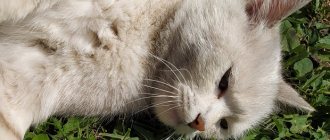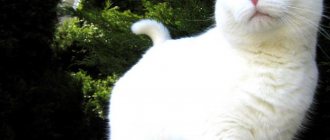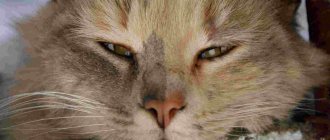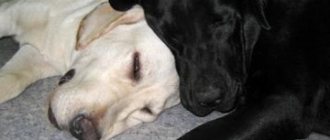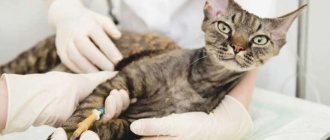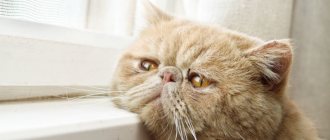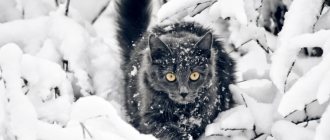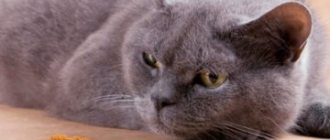4904Pavel
It is advisable for every loving owner to know the symptoms of pneumonia in cats, so that if problems with the health of their pets arise, they can promptly provide them with the necessary help. For a cat, as for a dog, pneumonia is a serious challenge. The route of infection of an animal can be different. If you miss the onset of pneumonia, there is a serious threat to the cat’s life, and even treatment does not always save the pet. At a young age and in good health, pneumonia is not common in cats. However, with age or poor environmental conditions, the lungs become very vulnerable, and pneumonia can occur one after another.
Causes of pneumonia
Most often, pneumonia in cats is due to 3 reasons. These include:
- bruises or open wounds of the chest;
- infectious (fungal, bacterial, viral) diseases, helminthiases and protozoan infections;
- involuntary ingestion (aspiration) of liquids (medicines, vomit) and foreign objects (insects, small debris).
Separately, it is worth noting pneumonia in a kitten caused by doctor’s negligence. If the baby is prescribed artificial feeding, then incorrect insertion of the tube can injure his lung tissue.
In addition to the main cause, there are also predisposing factors that undermine the animal’s immunity. These include:
- lack of vitamins and minerals in the diet;
- lack of vaccinations and antiparasitic treatment;
- recent surgery, chemotherapy, or long-term use of immunosuppressive drugs;
- untreated diseases;
- neglect of hygiene;
- the presence of allergic reactions;
- hypothermia;
- frequent stress.
Regardless of the cause, the possible consequences are always equally dangerous. They can be avoided if warning signs are detected early.
How owners can further help
To help your pet recover, just follow these simple rules:
- Attempting self-medication is strongly discouraged.
- It is important to follow all the veterinarian’s instructions, despite the fact that treatment can take from 3 weeks to 1.5 months. Do not make any independent adjustments to the therapeutic regimen and do not interrupt courses of taking medications without instructions from a specialist.
- Provide your pet with rest, high-quality, nutritious and balanced food during treatment, and protect him from potential stress.
- If there is a decrease or absence of appetite, forced feeding of semi-liquid food, high in protein and easily digestible, is indicated.
- Do not give your cat cold water or cold food.
- Do a light tapping massage of the chest.
- During the treatment period, try not to overload the cat with games, so as not to provoke shortness of breath, increased fatigue and oxygen starvation.
Author:
Grinchuk Ekaterina Andreevna veterinarian
Symptoms of pathology
The severity of symptoms of pneumonia in cats depends on the form and severity of the disease. It is most difficult to notice changes in chronic pathology characterized by a sluggish course, or at the very early stage. In these cases, the symptoms are slightly different from the common cold. More precisely, the pathology is confirmed by specific signs:
- discharge of serous (serum-like), fibrinous (dense in consistency) or purulent exudate from the nose;
- frequent sneezing;
- breathing problems and wheezing;
- increased heart rate;
- blueness of mucous membranes;
- dry cough, gradually turning into wet;
- loss of consciousness.
A sick pet loses activity and often sleeps. His appetite decreases or completely disappears. The presence of fever is typical only in cases of infection; in other cases, the temperature does not rise above 0.5 °C.
Animals at risk
The main factors predisposing to the development of infectious inflammation of the bronchi and lungs are hypothermia and poor nutrition. In this regard, veterinary specialists have identified the following risk groups:
- Premature and weak kittens . In young pets, the immune system is poorly developed, and minor errors in maintenance and feeding can lead to pneumonia.
- Stray cats and cats . Living in the cold, in unheated rooms, street animals are regularly exposed to hypothermia. A poor diet and irregular meals greatly undermine the body's immune system.
- Pets in shelters . In addition to poor nutrition, in such establishments animals are kept crowded, in poorly ventilated, cold rooms, which also provokes disease.
- Animals weakened by other diseases. The presence of helminths, vitamin deficiencies, viral rhinitis and other respiratory pathologies, chronic infectious diseases provoke the development of pneumonia.
- Elderly pets . Pneumonia in an aging cat is a fairly common disease due to decreased immunity and deterioration of thermoregulation processes.
- Pre-existing diseases , especially viral and fungal ones.
- Immunodeficiency conditions.
Pets may be at risk of pneumonia due to prolonged stressful situations, unsatisfactory living conditions, poor nutrition and poor diet. Frequent bathing, as well as feeding your pet frozen foods, provoke inflammation.
We recommend reading about how to treat a cat's wound. You will learn about the causes of wounds, whether there is a need for treatment, and the rules for treating open and purulent wounds. And here is more information about what to do if your cat has severe salivation.
Danger of pneumonia
Detection of the disease too late can result in damage to most of the lung tissue. This has a detrimental effect not only on the respiratory system, but also on other related organs that fight infectious intoxication.
At-risk groups
The risk group consists of animals deprived of a balanced diet and comfortable living conditions. These include:
- shelter residents living in small, cold spaces with poor ventilation;
- homeless cats forced to fight daily for food and find a roof over their heads;
- pets weakened by chronic diseases or frequent helminthiases.
The age factor should also be taken into account. The weakest immunity is typical for premature kittens and older pets.
Complications
If signs and symptoms of pneumonia appear in a cat, treatment should not be delayed. Diagnosis in late stages leads to an unfavorable prognosis. Prolonged development of the disease is fraught with chronicity of the process, pulmonary edema and blood poisoning.
The kidneys and liver suffer greatly from intoxication. All these changes are a huge burden on the body of a furry pet. With severe damage to the lung tissue, death is inevitable.
List of drugs, antibiotics and vitamins
An approximate list of drugs, antibiotics and vitamins used in the treatment of pneumonia.
- Cats are usually prescribed cephalosporin antibiotics (eg, Ceftriaxone).
- As an expectorant, you can use the “classics” in the form of plantain or coltsfoot decoction. In addition, cats are allowed to be given Mucaltin, “Cough Tablets” and licorice extract. Drugs that block the cough reflex are prescribed only with the knowledge and approval of the veterinarian!
- Saline solution, glucose and Ringer's solution, and calcium borogluconate are administered intravenously. All these remedies help to quickly relieve intoxication.
- Among multivitamin preparations, we can recommend 8 in 1 Excel Brewer's Yeast, Beaphar Kitty's Mix, "FeliDerm" (AniVital), as well as regular Trivit or Tetravit.
- Dexamethasone is often prescribed to relieve inflammation.
Types of pneumonia
Based on the severity of symptoms and the speed of progression of pneumonia in cats, acute and chronic forms are distinguished. Secondary inflammations include those that arise due to other diseases. If the pathology developed independently, then it is called primary.
Depending on the degree of lung damage, there are 2 forms: lobar and catarrhal. In the first case, inflammation covers most of the lung tissue, and in the second, only a small area.
Due to the inflammatory process, pathology occurs:
- Aspiration
. Aspiration pneumonia in cats is not associated with infection. It is caused by chest trauma and inhalation of foreign objects or liquids.
- Infectious
. Infectious pneumonia in cats is caused by pathogenic microorganisms: viruses, helminths, bacteria, fungi or protozoan parasites.
The most dangerous forms include bacterial and lobar. If they are detected, artificial ventilation is used to save the animal.
What causes pathology and how is it classified?
Pneumonia is a pathological condition in which an animal has difficulty breathing due to pulmonary edema and narrowing of the lumen of the bronchi due to accumulated pus and fluid. Viruses and bacteria complicate the process, and the following factors can initially provoke the inflammatory process:
- complications due to any respiratory infections, bronchitis;
- chest bruises, injuries, hematomas;
- infection by lung helminths;
- decreased immunity for any reason;
- hypothermia for a long time, reaction to drafts;
- hypothermia after swimming with prolonged exposure to wet hair;
- cold drinking water or food;
- inhaling something foreign.
By the nature of the pathogen, pneumonia is provoked;
- viruses;
- bacteria;
- fungi;
- parasites;
- inhaled foreign bodies (aspiration pneumonia).
Bacterial pneumonia
It is caused by bacteria and is considered the most common form. When sputum is cultured to identify bacteria, Pasteurella spp. is most often isolated. and Bordetella bronch. In addition, cats have a chlamydia form with the specific pathogen Chlamydophila psittaci.
Parasitic (invasive) pneumonia
The name speaks for itself - when infected with worms, this particular form of pathology develops. Most often, roundworms are involved in this, less often - capillaries (Capillaria aerophila) or nematodes (Aelurostrongylus abstrusus). In newborn offspring, the pathology is incurable; infection occurs in utero.
Viral pneumonia
The most difficult form to diagnose, caused by a viral infection. It rarely occurs as an independent disease; most often it occurs as a complication against the background of other infections - for example, calicivirosis and rhinotracheitis. Roto- and coronaviruses act as pathogens. Often complicated by bacteria.
Fungal infection
It can be an independent disease, or it can occur as a complication of the main one. Most often these are cryptococcosis and aspergillosis. It is very difficult to diagnose and takes the longest to treat.
Aspiration pneumonia
Appears when a foreign object enters the respiratory tract. The most common cause of this situation is improper artificial feeding of kittens, when food particles are inhaled, as well as incorrect use of liquid forms of intranasal medications. Also, such pneumonia can develop when inhaling droplets of fine chemical liquids.
It is possible to distinguish one from the other only by blood tests with sputum cultures to isolate the pathogen. Considering the severity of the disease and the rate of progression, a blood test is indicated immediately upon contacting the clinic. It determines the presence of inflammation and its nature.
Accurate diagnosis
Before deciding how to treat pneumonia in a cat, the veterinarian must rule out the presence of pathologies with similar symptoms. A similar clinical picture is typical for pets suffering from calcivirosis, rhinitis, bronchitis, tracheobronchitis and acute tonsillitis. Despite the similarities, the treatment for these diseases is different. Choosing medications on your own can worsen the animal’s condition.
Pathological noises and changes in the boundaries of the affected organ are detected by listening (auscultation) and tapping (percussion) of the chest. This type of examination assesses the physical condition of the lungs.
An x-ray shows a more accurate picture. The veterinarian takes a picture in frontal and lateral projections, which allows one to assess the existing lesions of the lung tissue. The diagnosis is confirmed by identifying a dark spot with blurry boundaries.
The list of mandatory studies also includes blood biochemistry, sputum analysis and bronchial swabs. Based on the results of these tests, the veterinarian confirms the presence of a specific infection. This helps to select drugs aimed at destroying a specific pathogen.
Feeding a cat when sick
Considering how much a pet weakens during illness, feeding a cat during illness also becomes of great importance:
- If the cat does not eat at all, “feed” it by injecting a glucose solution intravenously.
- When the pet's condition begins to improve, it can be given veterinary holistic treatments. We recommend special lines from Purina and Hills.
- If it is not possible to purchase holistic supplements, a weakened cat is fed boiled chicken or rabbit. Beef liver is given three times a week, and low-fat cottage cheese three times a week.
- By the end of the second week of treatment, the animal can be transferred to its usual diet.
How is pneumonia treated in cats?
Features of treatment and the duration of the recovery period depend on the cause of the disease and the degree of tissue damage. At the initial stage, the animal is treated at home.
If there is extensive damage to the lung tissue, trauma or a foreign body is detected, surgery and artificial ventilation may be necessary. In this case, the pet remains in the hospital until the condition stabilizes.
Veterinarian appointments
In addition to oxygen deprivation, dangerous symptoms include severe exhaustion, fever and complete refusal to eat. In all these cases, the mustachioed patient is provided with first aid in a hospital setting.
If the animal’s condition is unstable or critical, it is important to stabilize it and eliminate the cause of the problems that have arisen. Only after this do doctors begin to restore the lungs, relieve symptoms and stimulate the immune system. Dehydrated and malnourished patients are given intravenous drips. Infusion therapy helps restore strength by bypassing regular feeding.
If a bacterial infection is detected, the patient is prescribed antibiotics (Moxifloxacin, Azithromycin, Levofloxacin, Amoxicillin). To achieve quick results, injection solutions are used. Once in the blood, the active substance immediately reaches the desired organ. The duration of antibiotic therapy ranges from 2 weeks to 1 month. Animals infected with legionella or chlamydia take the longest to treat.
In case of fungal or viral infection, antimycotics or antiviral drugs are prescribed. Helminth infections are treated by taking anthelmintics. If complications occur in other organs, cardiac medications and hepatoprotectors may be required, and in case of edema, diuretics (Furosemide).
During treatment, it is prohibited to use antitussives. They prevent the discharge of sputum, worsening the animal's condition. Mucolytics (Mukaltin, Lazolvan) are used to liquefy it, and expectorants and physiotherapy are used to remove it. Recommended procedures include UHF heating, chest massage and electrophoresis. They are carried out until the cough is eliminated, but are prescribed only after the acute form has been eliminated.
Due to prolonged use of antibiotics, which have a detrimental effect on the immune system, all patients are prescribed immunomodulators (Fosprenil, Gamavit). Particular attention is paid to vitamins B and C. They are administered intramuscularly.
Do not use traditional medicines that are not approved by your doctor. They are effective only in complex therapy and do not eliminate the root cause. Herbal treatment to increase immunity is permissible only in the absence of allergies.
Nutrition and care
A pet with a stable condition and an awakened appetite can be treated at home. He will need a quiet and warm place to recover comfortably. Remember that both drafts and heating devices located too close are equally dangerous for the patient. If the animal is cold, cover it with a blanket or blanket.
Also remember to make sure there is no noise. Place the sick cat in a quiet room and temporarily limit his contact with children.
If you have your own home, then do not let your pet outside during the entire recovery period. Low temperature, which is a provoking factor, can negate treatment. Provide fresh air with regular ventilation and purchase a humidifier.
If there is an increased accumulation of secretions in the bronchi, massage or heating with an infrared lamp is allowed. The veterinarian will clarify the specifics of these procedures.
To restore strength, your mustachioed pet will need a balanced, low-fat diet. Food should be satisfying, but easily digestible. When feeding naturally, focus on foods rich in potassium and vitamins A, B and C.
To reduce the load on the stomach, reduce the usual portions and increase the number of feedings to 6 times a day. Do not forget to monitor the sufficient amount of water, its freshness and temperature - too cold dishes and liquids can aggravate the patient’s condition.
Recovery period
On average, recovery takes from 3 to 6 weeks, but in particularly severe cases it can take up to 2 months. The duration of the rehabilitation period depends on:
- compliance with care and feeding recommendations;
- degree of damage to lung tissue;
- general condition of the patient;
- severity of existing symptoms.
Adjustment or discontinuation of drug therapy is determined using x-rays. The frequency of examinations is individual and agreed with the attending physician.
Symptoms and first signs of the disease
Pneumonia is characterized by the following symptoms and first signs of the disease:
- Cough. In many cases it is initially hard and barky, but subsequently softens to become moist. At the same time, wheezing and gurgling appear in the chest.
- Spontaneous and sharp increase in general body temperature. A fever of a constant or intermittent type is considered typical; temperature “swings” are often observed when the animal alternately becomes hot and then noticeably “cold.” This has an extremely bad effect on the state of the vascular system and old/very young animals can die already at this stage.
- Shortness of breath, hoarse and difficult breathing. Sometimes the cat begins to whistle and snore, reminiscent of a boiling kettle. In severe cases, breathing becomes so difficult that all visible mucous membranes turn blue. In such situations, by the way, it is necessary to urgently call the veterinarian: such severe hypoxia is extremely dangerous and rarely goes away without serious consequences (including for the brain).
- There may be visible enlargement of the subcutaneous lymph nodes.
- The animal refuses food. Thirst, as a rule, either remains at the same level or intensifies.
Recommended Prevention
To prevent diseases of the lower respiratory tract, it is important to maintain your pet’s immunity by creating comfortable living conditions. This will help you:
- Quality diet
. A sufficient amount of vitamins, regular feeding and the absence of harmful foods are a reliable foundation for the formation of a strong immune system.
- Annual vaccination and quarterly deworming
. The resulting immunity reduces the likelihood of infection and eliminates the acute course in case of illness.
- Timely treatment of other pathologies
. Neglect of medical instructions or too late treatment are common reasons that provoke the addition of the inflammatory process.
- Preventing contact with stray animals
. Do not let your pet go for a walk without a harness. Free walking is allowed only in the fenced area of a private house.
- Maintaining a comfortable room temperature
. Do not place the bed next to a window and avoid cold ventilation in the presence of your pet.
A strong immune system is the key to a favorable prognosis. The better the conditions in which the pet is kept, the easier the inflammation is tolerable.
If you notice difficulty breathing in your cat, seek help immediately. Do not expect sudden self-healing and do not listen to the advice of friends. Only a doctor can tell you an accurate prognosis, so do not rely on chance and be sure to get diagnosed if any alarming symptoms occur.
The article is for informational purposes only. Contact your veterinarian!
Treatment
Therapeutic measures are aimed at eliminating the cause and eliminating symptoms. Since in all cases there is a proliferation of secondary microflora, universal antibiotics are used. When test results become known, treatment is adjusted using targeted antimicrobial drugs.
Antibiotic therapy is carried out under the supervision of a doctor, because unqualified treatment can cause harm. All potent drugs have a side effect that affects the contagion and parenchymal organs of the cat. Premature interruption of the course of treatment leads to the fact that the disease returns, and the pathogen becomes immune to the drugs used.
Symptomatic treatment involves releasing the bronchi and alveoli from accumulated inflammatory products. For this purpose, agents are used that stimulate the secretion of mucus, removing a mixture of secretions and pathological products from the body.
To remove excess fluid accumulated during inflammation from the respiratory system, diuretics are used. Pacemakers are used to keep the heart pumping.
A side effect of antibiotic therapy is the destruction of opportunistic microflora and beneficial intestinal microorganisms. Without the participation of the latter, it is impossible to complete the process of formation of fecal masses, therefore dysbacteriosis develops, manifested by the occurrence of diarrhea. Sorbents and probiotics are used to restore intestinal function.
In the fight against pathogenic factors, the body mobilizes all reserves, consumes reserves of vitamins and other biologically active substances, so there is a need to replenish what has been expended.
An integral part of the treatment process is creating comfort for a sick cat. For this purpose, multivitamin preparations are used, for example, Gamavit, immunomodulators, probiotics, and substances that eliminate the effects of intoxication.
Nobivak

